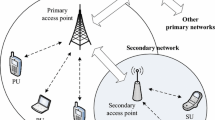Abstract
Auction is often applied in cognitive radio networks due to its efficiency and fairness properties. An important issue in designing an auction mechanism is how to utilize the limited spectrum resource in an efficient manner. In order to achieve this goal, we propose a predictive double spectrum auction model in this paper. Our auction model first obtains the bidding range from statistical analysis, and then separates the interval into independent states and employees a Markovian prediction based algorithm to generate guidelines for the bidding range of primary and secondary users, respectively. Comparing with existing approaches, our proposed auction model is more efficient in spectrum utilization and satisfies the economic properties. Extensive simulation results show that our work achieves an utilization ratio up to 91 %.








Similar content being viewed by others
Notes
To simplify the description, we use the item “bid” to present \(M_{j}^{s}(t)\) of \(p_j\) or \(M_{i}^{b}(t)\) of \(s_i\) in the following.
References
Liu, Z., Wang, S., Wu, W., Tian, X., Li, C., & Wang, X. (2014). A predictive methodology for truthful double spectrum auctions in cognitive radio networks. In Proceedings of IEEE GLOBECOM (pp. 1017–1022).
Rappaport, T. S. (2002). Wireless communications: Principles and practice. Upper Saddle River: Prentice-Hall PTR.
FSPT Force. (2002). Report of the spectrum efficiency working group. FCC Spectrum Policy Task Force (SPTF), no. 03-237.
Mitola, J. (2000). Cognitive radio: An integrated agent architecture for software defined radio (pp. 271–350). Royal Institute of Technology (KTH), Doctor of Technology. http://www.citeulike.org/group/17835/article/9342875.
Liang, Q., Wang, X., Tian, X., Wu, F., & Zhang, Q. (2014). Two-dimensional route switching in cognitive radio networks: A game-theoretical framework. IEEE/ACM Transactions on Networking, 99, 1–14.
Xu, Y., Wang, J., Wu, Q., Anpalagan, A., & Yao, Y.-D. (2012). Opportunistic spectrum access in cognitive radio networks: Global optimization using local interaction games. IEEE Journal of Selected Topics in Signal Processing, 6(2), 180–194.
Xu, Y., Wang, J., Wu, Q., Anpalagan, A., & Yao, Y.-D. (2012). Opportunistic spectrum access in unknown dynamic environment: Game-theoretic stochastic learning solution. IEEE Transactions on Wireless Communications, 11(4), 1380–1391.
Gao, L., Wang, X., Xu, Y., & Zhang, Q. (2011). Spectrum trading in cognitive radio networks: A contract-theoretic modeling approach. IEEE Journal on Selected Areas in Communications, 29(4), 843–855.
Wang, X., Li, Z., Xu, P., Xu, Y., Gao, X., & Chen, H.-H. (2010). Spectrum sharing in cognitive radio networks—An auction based approach. IEEE Transactions on Systems, Man and Cybernetics-Part B: Cybernetics, 40(3), 587–596.
Xu, Y., Anpalagan, A., Wu, Q., Shen, L., Gao, Z., & Wang, J. (2013). Decision-theoretic distributed channel selection for opportunistic spectrum access: Strategies, challenges and solutions. IEEE Communications Surveys and Tutorials, 15(4), 1689–1713.
Iosifidis, G., & Koutsopoulos, I. (2010). Double auction mechanisms for resouce allocation in autonomous networks. IEEE Journal on Selected Areas in Communications, 28(1), 95–102.
Wang, Q., Ye, B., Xu, T., Lu, S., & Guo, S. (2012). DOTA: a double truthful auction for spectrum allocation in dynamic spectrum access. In Proceedings of IEEE WCNC (pp. 1490–1495).
Wang, W., Liang, B., & Li, B. (2014). Designing truthful spectrum double auctions with local markets. IEEE Transactions on Mobile Computing, 13(1), 75–88.
Feng, X., Chen, Y., Zhang, J., Zhang, Q., & Li, B. (2012). TAHES: Truthful double auction for heterogeneous spectrums. In Proceedings of IEEE INFOCOM (pp. 3076–3080).
Xu, H., Jin, J., & Li, B. (2010). A secondary market for spectrum. In Proceedings of IEEE INFOCOM (pp. 1–5).
Li, D., Xu, Y., Wang, X., Xu, Y., & Guizani, M. (2011). Coalitional game theoretic approach for secondary spectrum access in cooperative cognitive radio networks. IEEE Transactions on Wireless Communications, 10(3), 844–856.
Zhou, X., & Zheng, H. (2009). TRUST: A general framework for truthful double spectrum auctions. In Proceedings of IEEE INFOCOM (pp. 999–1007).
Li, C., Liu, Z., Geng, X., Dong, M., Yang, F., Gan, X., et al. (2014). Two dimension spectrum allocation for cognitive radio networks. IEEE Transactions on Wireless Communications, 13(3), 1410–1423.
McAfee, R. (1992). A dominant strategy double auction. Journal of Economic Theory, 56(2), 434–450.
Hiscott, R. N. (1981). Chi-square tests for Markov chain analysis. Journal of the International Association for Mathematical Geology, 13(1), 69–80.
Davis, J., & Sampson, R. (2002). Statistics and data analysis in geology. New York: Wiley.
Ramanathan, S. (1999). Two-dimensional route switching in cognitive radio networks: A game-theoretical framework. Wireless Networks, 5(2), 81–94.
Reis, C., Mahajan, R., Rodrig, M., Wetherall, D., & Zahorjan, J. (2006). Measurement-based models of delivery and interference in static wireless networks. In Proceedings of ACM SIGCOMM (pp. 51–62).
Subramanian, A. P., Gupta, H., Das, S. R., & Buddhikot, M. M. (2007). Fast spectrum allocation in coordinated dynamic spectrum access based cellular networks. In Proceedings of IEEE DySPAN (pp. 320–330).
Choji, D. N., Eduno, S. N., & Kassem, G. T. (2013). Markov chain model application on share price movement in stock market. Computer Engineering and Intelligent Systems, 4(10), 84–95.
Ghezzi, L. L., & Piccardi, C. (2003). Stock valuation along a Markov chain. Applied Mathematics and Computation, 141(2/3), 385–393.
Anderson, T. W., & Goodman, L. A. (1957). Statistical inference about Markov chains. The Annals of Mathematical Statistics, 28(1), 89–110.
Miall, A. D. (1973). Markov chain analysis applied to an ancient alluvial plain succession. Sedimentology, 20(3), 347–364.
Harbaugh, J. W., & Bonham-Carter, G. (1970). Computer simulation in geology. New York: Wiley.
Acknowledgments
This work was supported by the National Natural Science Foundation of China under Grant Nos. 61271176, 61401334, 61571350, 61532012, 61325012, 61271219, 61221001, and 61428205; the Fundamental Research Funds for the Central Universities (BDY021403, JB140113); and the 111 Project (B08038).
Author information
Authors and Affiliations
Corresponding author
Additional information
The early version of this paper is appeared in the Proceedings of IEEE Globecom 2014 [1].
Rights and permissions
About this article
Cite this article
Liu, Z., Li, C. On spectrum allocation in cognitive radio networks: a double auction-based methodology. Wireless Netw 23, 453–466 (2017). https://doi.org/10.1007/s11276-015-1152-4
Published:
Issue Date:
DOI: https://doi.org/10.1007/s11276-015-1152-4




